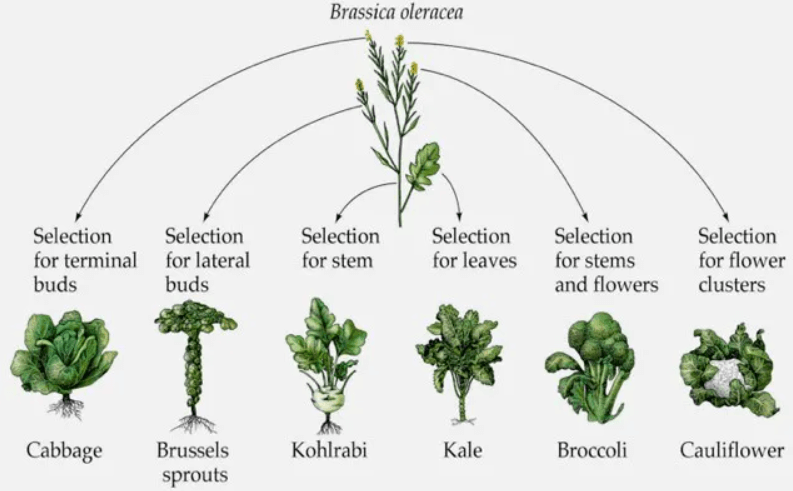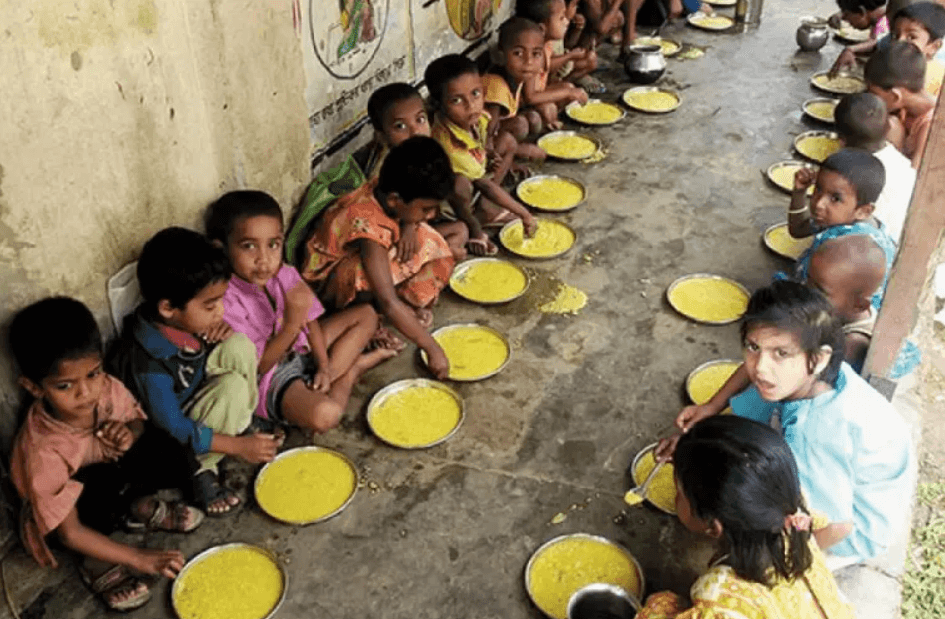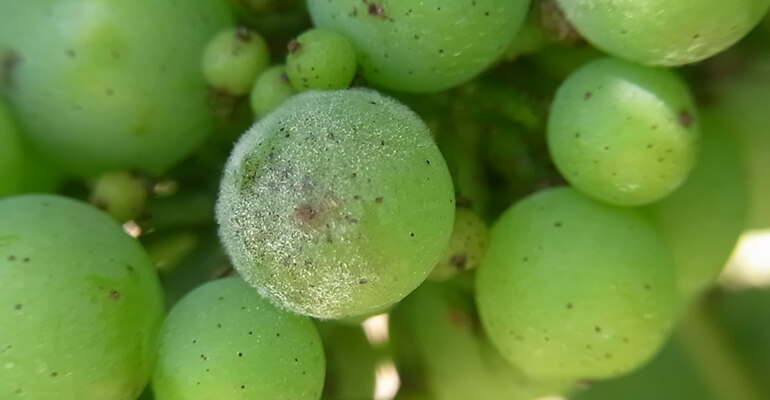Despite the objections and protestations of the anti-GMO advocates who equate genetic engineering with “Frankenfoods” and utilize fear and scare tactics to try to frighten people from consuming GMOs, genetically modifying crops is not a new phenomenon.
Mankind has been doing it for tens of thousands of years through a process of selective breeding, cross pollination, grafting, cell and tissue cultures and more recently through the use of mutagenesis which involves bombarding a seed with chemicals, gamma rays or X-rays to get a desired trait. As a result, the crops we consume today do not resemble the crops we consumed thousands of years ago. They are hardier, tastier and more nutritious.
Without these methods there would be no seedless grapes and watermelons, no pink grapefruits, no hybrids such as tayberries, plumcots, peacharines, tangelos, broccoflower and limequats and no broccoli, cauliflower, kale, cabbage, cauliflower, brussels sprouts and collard greens which are derived from the plant species brassica oleracea. There would also not be as many different varieties of apples, tomatoes, oranges and melons. Humankind has essentially been utilizing genetic engineering ever since farming began.

In 2019, about 8.9 percent of the world population, or 690 million people, were considered to be undernourished. This total probably increased recently because of the COVID pandemic, which led to a loss of economic activity in many developing countries. It is also likely to rise still further as the war in Ukraine has sent the prices of several food staples, such as corn, barley and wheat, surging higher as Russia and Ukraine are major producers and exporters of these crops.
A 2020 paper from two Pakistan biologists, “Transgenic Crops for Biofortification,” noted,
It is evident that biofortification holds great promise for improving the nutritive value of major crops. By the use of recombinant DNA technology, the bioavailability of several essential micronutrients and vitamins could be increased…
A GE way to fight vitamin A deficiency
Vitamin A deficiency is a major problem especially in developing countries. The US Centers for Disease Control (CDC) estimates that 190 million pre-age school children throughout the world suffer from vitamin A deficiency.
According to the World Health Organization,
Night blindness is one of the first signs of vitamin A deficiency. In its more severe forms, vitamin A deficiency contributes to blindness by making the cornea very dry, thus damaging the retina and cornea. An estimated 250,000–500,000 children who are vitamin A-deficient become blind every year, and half of them die within 12 months of losing their sight.
Genetic Engineering provides a possible solution to vitamin A deficiency by creating crops that are high in beta carotene, which once consumed can be converted into vitamin A. Golden rice was specifically designed to deal with Vitamin A deficiency.
Golden Rice has had a long and arduous journey to cultivation. From its genesis in the 1980s, it took longer than expected to develop and was dogged by fear mongering among anti-GMO advocates who claimed it was potentially hazardous to human and animal health and the environment. There was also a lengthy testing process. Finally, in 2021, the Philippines, where only two out of 10 households meet the estimated average requirement for vitamin A intake in their daily diet, approved its cultivation. According to the Philippine Rice Research Institute, a one-cup portion of cooked Golden Rice contains enough beta-carotene to meet up to 30%-50% of the estimated average requirement of vitamin A for children aged 6 months to 5 years.

Golden Rice is awaiting final approval for cultivation in Bangladesh.
Vitamin A engineering — non-Golden Rice
Other plants are also being tested for their ability to deliver vitamin A. Scientists in Uganda have developed a vitamin A Golden banana. It cannot, however, be commercially cultivated until President Museveni signs the Biosafety Law, which he has been reluctant to do because he wants provisions included for patent rights for indigenous farmers and sanctions for scientists who mix GMOs with indigenous crop breeds.
Scientists in Australia have also created a vitamin A banana by taking a gene from a species of banana in Papua New Guinea and inserting into a Cavendish banana.
Scientists in Ghana, meanwhile, are working on developing a vitamin A sweet potato.
Other vitamins and minerals
Scientists have engineered crops to have enriched iron and zinc content. According to the US Centers for Disease Control and Prevention (CDC), iron deficiency is a leading cause of anemia, which affects 40% of children younger than five years of age and 30% of pregnant women globally. Zinc, meanwhile, promotes immune functions and helps people ward off infections, including diarrhea, pneumonia and malaria. Worldwide, 17.3% of the population is deficient in zinc.
Scientists in Nigeria have developed a GMO cassava that is high in zinc and iron. Conventionally grown cassava provides about 10% of the recommended dietary levels of iron and zinc. The GMO biofortified cassava however has iron levels 7–18 times higher and zinc levels 3–10 times higher than conventional cassava.
A GMO biofortified iron and zinc rice has also been developed by scientists.
Developing countries are also boosting health by improving the nutritional content of foods. In the major industrial countries, foods can be altered to reduce fat content and possibly lower blood pressure. This is particularly important as many people in the developed world are not consuming the daily recommended amounts of fruits and vegetables.
In February 2019, Minnesota based agribiotechnology company Calyxt announced the commercial launch of its high oleic soybean oil, Calyno, to the food service industry for frying and salad dressing, as well as sauce applications. The oil was developed using gene-editing technology. According to the company’s press release:
Calyno oil contains approximately 80 percent oleic acid and up to 20 percent less saturated fatty acids compared to commodity soybean oil as well as zero grams of trans fat per serving. One of the exciting potential sustainability benefits of Calyno oil is that it has up to three times the fry life and extended shelf life compared to commodity oils.

In September 2021, Calyxt, announced it had entered into a research collaboration with an Asian food ingredient manufacturer to develop
an improved soybean capable of producing an oil as a commercial alternative to palm oil. In addition to the potential health benefits, this soybean and its oil may address sustainability challenges associated with palm oil, such as…palm oil’s impact on biodiversity.
Scientists at the Rothamsted Institute in Hertfordshire, in the UK, in conjunction with Yield 10 Bioscience of the US, have been able to genetically modify Camelina sativa, a relative of oil seed rape, to produce omega-3 fatty acids, normally sourced from fish oil. Field trials indicate the fish oil contains high levels of EPA and DHA, both key ingredients of fish oils. They are linked to improvements in blood lipid levels, reduced tendency for thrombosis, blood pressure and heart level improvements, improved vascular functions and help with eye and joint health and infant development.
Nufarms of Australia has genetically engineered canola to develop omega 3 fish oil. According to Nufarms, one hectare of its omega 3 canola could yield the equivalent of fish oil from 10,000 kilograms of wild caught fish. This is particularly important in helping to slow overfishing, which is decimating many fish stocks. In August 2021, the FDA acknowledged Nuseed’s (a subsidiary of Nufarm that developed the fish oil) omega-3 canola oil as a New Dietary Ingredient.
Cathie Martin, a plant biologist, working at the John Innes Center of the UK, has developed a purple tomato via gene-editing that has a high content of anthocyanin, a naturally occurring anti-inflammatory compound. According to Martin,
All higher plants have a mechanism for making anthocyanins. A tomato plant makes them as well, in the leaves. We just put in a switch that turns on anthocyanin production in the fruit.
Cancer-prone mice that were fed the purple tomatoes as part of their diet lived 30% longer than mice fed ordinary tomatoes and were less susceptible to inflammatory bowel disease. Several of the purple tomato varieties are in the final stages of lengthy and exhaustive review process in the United States and approval for commercial sales are likely to be granted in the near future.
Tomatoes have been genetically engineered to have five times the amount of lycopene as conventionally grown tomatoes. Lycopene is believed to lower the risk of cancer and cardiovascular diseases.
Building better crops
Perhaps one of the most important uses of the new forms of genetic engineering such as CRISPR and other gene editing techniques will be in creating crops that are disease resistant in a similar manner to vaccinations for childhood diseases such as measles and the mumps.
The GMO papaya is an example of the benefits of utilizing biotechnology to save a crop from the ravages of a spreading disease. The papaya crop in Hawaii was nearly destroyed by the spread of the ringspot virus which sent production of the crop plunging. Scientists were able to develop a GMO variety that is immune to the disease. It revitalized an industry that was on death’s door. The GMO Rainbow papaya was introduced in 1998 and within four years the spread of the ringspot virus disease was halted and production returned to levels that prevailed before the virus began its spread. About 90 percent of the papaya crop in Hawaii is now the GMO variety.

The scope of losses from plant diseases and viruses is enormous and was highlighted in a 2020 article in the journal Molecular Plant. It indicated:
Plant pathogens and pests are responsible for up to 40% of maize, potato, rice, soybean, and wheat crop yield losses worldwide. Plant diseases caused by bacteria, fungi, nematodes and viruses cost the global economy US$220 billion annually. Viruses make up almost half of the plant disease-causing pathogens, at an annual global cost of more than US$30 billion.
Rice is cultivated in 100 countries, supporting nearly half the world’s population, and is at risk from multiple vector-transmitted viruses, at a cost of US$1.5 billion annually….
Cassava mosaic begomovirus infection results in an annual crop loss of 25 million tons. With half a billion people relying on this staple for a source of calories, epidemics of this virus directly lead to famine…West African cacao production accounts for 70% of the world’s cacao supply. The loss of cacao plantations would devastate the local economy and lead to global cacao shortages. With 200 million trees dead due to CSSV infection, expensive eradication programs have been established to save the cacao industry….
Citrus … is at risk from Citrus tristeza closterovirus…. The most widely distributed viral disease of cereals, Barley yellow dwarf luteovirus of the Luteoviridae family infects barley, maize, rice, oat, and wheat crops that sustain the world’s population. Potato leafroll polerovirus is responsible for the annual loss of 20 million tons of potato, at a cost of US$100 million.
The eradication of plant diseases and viruses through the use of genetic engineering techniques can have a great impact in boosting farm income and reducing the cost of food to consumers. It will also slash the use of fungicides and other pesticides. As a recent paper in Cell noted, that’s key to gaining wider acceptance.
Annual sales of pesticides in the European Union amounted to almost 360,000 tons, with a 46% share of fungicides…. Even with the deployment of resistant cultivars and integrated control strategies, fungicides still contribute heavily to plant disease control in conventional farming. Even organic systems, although promoted for their environmental benefits, also depend on fungicides….
Recently, new fungal plant diseases have emerged worldwide associated with the globalization of trade and environmental change, thus further increasing farmers’ dependency on fungicides. Nevertheless, their use in agriculture has been associated with growing environmental and public health concerns. In addition to their negative environmental impacts (e.g., on biodiversity), some fungicides have been associated with increased risk to human health, particularly among farmers but also among people living in the vicinity of agricultural areas.
Global warming is expected to exacerbate the spread of crop diseases.
Barley yellow dwarf (BYD) disease, caused by the barley yellow dwarf virus, is considered the most destructive disease of major cereal crops. Transmitted by aphids as they feed, the virus can infect wheat, maize, oats, barley, and rice. In wheat alone, the disease is estimated to cause between roughly 10 to 30 percent losses in production. Cereal crop losses of over 70 percent from BYD are not uncommon when viral infections occur early in the plant growth cycle. Scientists generally agree on some of the effects of climate change on BYD. For example, the transmission efficiency of viruses from aphid to plant is expected to increase with warmer temperatures. Elevated carbon dioxide levels, such as those that cause warming through the greenhouse effect, increased the viral load in some cereal crops. Both effects would dampen yields in these crops.
Adam Bogdanove, a plant pathologist at Cornell University in Ithaca, New York, is using CRISPR technology to make rice that is resistant to bacterial leaf streak and blight, two of its most devastating diseases. Jan Leach, a plant pathologist at Colorado State University in Fort Collins, is experimenting with CRISPR and other gene-editing tools to breed rice that is resistant to a wide range of diseases, rather than just one.
Researchers at Rutgers University in New Jersey are using CRISPR to make wine grapes resistant to downy mildew. A team of US scientists have made tomatoes that are resistant to several bacteria while scientists in Beijing have made powdery-mildew-resistant wheat.

Solutions for combating crop diseases, funguses and viruses using genetic engineering tools are being vigorously pursued by scientists for virtually all major crops, including canola, apples, sorghum, cassavas, oranges, cocoa, coffee, and raspberries. Genetic engineering is also being used to bring back the chestnut tree in the US which has experienced a severe decline as a result of a blight that has killed an estimated 4 billion trees in the Eastern US. To do so, scientists transferred a single wheat gene into the cells of blight-stricken trees. This makes the tree more resistant to the fungus that causes blight. The same gene is also found in strawberries and barley.
A cure for potato late blight disease, which caused the infamous famine in Ireland, has been found with scientists in Ireland and the Netherlands developing a GMO potato with a blight resistance gene that could reduce fungicide spraying to up to 90 percent. Scientists from Wageningen University in the Netherlands and Teagasc, the Irish agricultural research agency, conducted three years of field testing in the two nations to test the effectiveness of the potato, which was developed through a process of cisgenesis that involved transferring a resistant gene from a wild potato variety. According to a Wageningen University press release:
Cisgenesis allows enrichment of existing potato varieties in as little as three years versus current potato breeding programs that require 10 years or more to produce a novel variety. In addition to accelerating the breeding process, cisgenesis is more accurate than using conventional crossbreeding and selection methods.
Scientists in Uganda have also developed a blight resistant potato. It is also a product of cigenesis using a wild potato variety. Research Scientist Abel Arinaitwe, who has been working on the project for the National Agricultural Research Organization, said,
The time needed to develop a blight-resistant potato by breeding is simply far too long if the goal is to protect farmers and consumers in Uganda and elsewhere in Africa who are facing the threat of blight right now and don’t have decades to wait for a solution. Their harvests are being ruined and the threat is spreading rapidly. And every year that passes without a solution to late blight is another year of stagnating incomes and increased risk of hunger and malnutrition.
In 2017, the EPA granted approval for J.R. Simplot’ cisgenesis blight resistant potato which was created with genetic material form a wild South American potato variety. The company believes the potato will reduce the need for fungicide applications by up to 50%.
Perhaps the most endangered crop is the banana, the fourth most important crop in the world after wheat, rice and corn. It is being threatened globally by Panama disease, also known as banana wilt. The disease is linked to a soil inhabiting fungus that cannot be eradicated by fungicides and can linger in the soil for up to 30 years. In the 1950s, the disease wiped out the Gros Michel variety which was then the dominate banana forcing growers to replace it with the Cavendish variety. It is now the main exported and consumed banana. The Cavendish is now threatened. This would be a devastating development as the UN’s Food and Agriculture Organization has estimated that the Cavendish variety accounts for about half of all banana production in the world and almost all exports which totaled $14.7 billion in 2020. Bananas are
Although Asia is the largest banana growing region in the world with India the largest producer followed by China, central and South America are the largest exporters. As a result, there are concerns that the spread of Panama disease will severely undermine economic activity and employment in those countries that are heavily dependent on bananas to generate export receipts. This is particularly so with regard to Ecuador which is the largest banana exporter in the world. Concerns were heightened when the fungus that causes Panama disease was discovered in Colombia in 2019. The banana industry and associated industries account for about 2 million jobs or 17 percent of the labor force. In 2020, bananas were Ecuador’s third largest export earner after oil and fish, accounting for 18.2 percent of the total.
Scientists have developed a genetic engineered solution to banana wilt that if implemented will halt the potential decimation of the crop. In this regard, genetic engineering may be the only solution as conventional breeding techniques will take too long to accomplish the task. In Australia, a scientific team led by James Dale, a biotechnologist at Queensland University of Technology in Brisbane, inserted a gene from a wild banana into a Cavendish variety and tested it in field trials. These trials were successful in growing bananas immune to Panama disease. Dale is also editing the Cavendish’s genome with CRISPR technology in order to boost its resistance to Panama disease. That work though is in its early stages.
Leena Tripathi, a molecular biologist at the International Institute of Tropical Agriculture in Nairobi, is utilizing gene-editing tools to suppress genes in the Cavendish banana that make the plant susceptible to the Panama disease. She said there was proof of concept that suppressing a particular gene in the banana “showed enhanced resistance to banana wilt“ and did not show any detrimental effect on plant growth. However, the performance of these bananas “needs to be evaluated in field conditions.”
Tropic Biosciences in Norwich, UK, is using CRISPR to edit RNA strands in the Cavendish banana so that they silence genes in Panama disease.
Wheat is the most important staple crop providing 20 percent of global calories. Losses from wheat rust pathogens worldwide are estimated at $4.3 billion to $5.0 billion per year. Researchers at CSIRO, Australia’s national science agency, in collaboration with the John Innes Center in the UK, the University of Minnesota, Aarhus University in Denmark, The USDA, Xinjiang University, and funding from the 2Blades Foundation, have been utilizing genetic engineering in order to create a rust resistant wheat variety by “stacking” resistance genes together. According to lead CSIRO researcher, Dr. Mick Ayliffe,
Our approach is like putting five locks on a door—you’re making it difficult to get in. Rigorous field testing showed that our gene stack approach provided complete protection against the rust pathogens we were targeting.
Two of the resistance genes that made up the stack of five were cloned by scientists using a technique called MutRenSeq which rapidly detects resistance genes in wheat. Wheat rust has been difficult to control because it can mutate thus making it hard to utilize conventional breeding techniques to control the disease. Multiple genes compiled in a gene stack though can strengthen the defenses of the wheat plant.
As Dr. Brande Wulff of the John Innes Centre noted,
With these technologies, some of the key obstacles and mystery associated with discovery and cloning of disease resistance genes in wheat and its wild relatives have been removed…Improved wheat genome assembly technologies and wheat transformation methods is likely to significantly lower further barriers over the next 2-4 years. This will provide the raw material for generating and testing multi-resistance transgene stacks, not just against stem rust, but against many other major diseases of wheat and other important crops.
Brazil has developed a GM bean that is resistant to Bean Golden Mosaic Virus, which causes estimated losses of 300,000 tons per year. In an effort to control the disease, which is spread by the whitefly, farmers have to apply 15-20 sprayings of insecticide a year. Francisco Aragao, the lead scientist that developed the bean indicated that farmers cultivating the bean would experience a 28-to-78 percent increase in profitability while reducing pesticide use to just three per season.
The use of genetic engineering is an important tool to enhance the nutritional content of the foods we consume and combatting plant diseases. It is therefore essential that it be used in growing crops to produce foods that will improve health outcomes and greatly diminish the losses that result from plant diseases that cause billions of dollars a year in crop losses.
Steven E. Cerier is an international economist and a frequent contributor to the Genetic Literacy Project.































